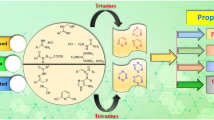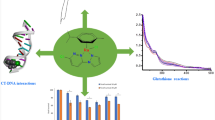Abstract
A comparative study of the halide and benzoate anion binding properties of a series of phenyl, pyrrole, and furan-strapped calix[4]pyrroles has been carried out. These receptors, which have previously been shown to bind the chloride anion (Yoon et al., Angew. Chem., Int. Ed. 47(27):5038–5042, 2008), were found to bind bromide and benzoate anion (studied as the corresponding tetrabutylammonium salts) with near equal affinity in acetonitrile, albeit less well than chloride, as determined from ITC measurements or NMR spectroscopic titrations. This stands in marked contrast to the parent octamethylcalix[4]pyrrole, where the carboxylate anion affinities are substantially higher than those for bromide anion under identical conditions. This finding is rationalized in terms of tighter binding cavity present in the strapped systems. For all three anions for which quantitative data could be obtained (i.e., Cl−, Br−, PhCO2 −), the pyrrole-strapped system displayed the highest affinity, although the relative enhancement was found to depend on the anion in question. In the specific case of fluoride anion binding to the pyrrole-strapped receptor, two modes of interaction are inferred, with the first consisting of binding to the calix[4]pyrrole via NH-anion hydrogen bonds, followed by a process that involves deprotonation of the strapped pyrrolic NH proton. A single crystal X-ray diffraction analysis provides support for the first of these modes and further reveals the presence of a methanol molecule bound to the fluoride anion.



Similar content being viewed by others
Notes
In fact, the interaction of calixpyrrole 3 with TBABr actually has a favorable T∆S; while further analysis is required, this finding could reflect a solvation energy for bromide anion that is relatively small as compared to that of other anions considered in this study.
References
Yoon, D.-W., Hwang, H., Lee, C.-H.: Synthesis of a strapped calix[4]pyrrole: structure and anion binding properties. Angew. Chem. Int Ed. 41, 1757–1759 (2002)
Lee, C.-H., Na, H.-K., Yoon, D.-W., Won, D.-H., Cho, W.-S., Lynch, V.M., Shevchuk, S.V., Sessler, J.L.: Single side strapping: a new approach to fine tuning the anion recognition properties of calix[4]pyrroles. J. Am. Chem. Soc. 125, 7301–7306 (2003)
Lee, C.H., Lee, J.S., Na, H.K., Yoon, D.W., Miyaji, H., Cho, W.S., Sessler, J.L.: Cis- and trans-Strapped calix[4]pyrroles bearing phthalamide linkers: synthesis and anion-binding properties. J. Org. Chem. 70, 2067–2074 (2005)
Lee, C.-H., Miyaji, H., Yoon, D.-W., Sessler, J.L.: Strapped and other topographically nonplanar calixpyrrole analogues. Improved anion receptors. Chem. Commun. 24–34 (2008)
Yoon, D.-W., Gross, D.E., Lynch, V.M., Lee, C.-H., Bennett, P.C., Sessler, J.L.: Real-time determination of chloride anion concentration in aqueous-DMSO using a pyrrole-strapped calixpyrrole anion receptor. Chem. Commun. 1109–1111 (2009)
Fisher, M.G., Gale, P.A., Hiscock, J.R., Hursthouse, M.B., Light, M.E., Schmidtchen, F.P., Tong, C.C.: 1,2,3-Triazole-strapped calix[4]pyrrole: a new membrane transporter for chloride. Chem. Commun. 3017–3019 (2009)
Yoon, D.-W., Gross, D.E., Lynch, V.M., Sessler, J.L., Hay, B.P., Lee, C.-H.: Benzene-, pyrrole-, and furan-containing diametrically strapped calix[4]pyrroles-an experimental and theoretical study of hydrogen-bonding effects in chloride anion recognition. Angew. Chem. Int Ed. 47, 5038–5042 (2008)
Fujiwara, F.W., Martin, J.S.: The heterobihalide ions. Nuclear magnetic resonance spectroscopy of strong hydrogen bonds. J. Am. Chem. Soc. 96, 7625–7631 (1974)
Camiolo, S., Gale, P.A., Hursthouse, M.B., Light, M.E., Shi, A.J.: Solution and solid-state studies of 3,4-dichloro-2,5-diamidopyrroles: formation of an unusual anionic narcissistic dimer. Chem. Commun. 758–759 (2002)
Gale, P.A., Navakhun, K., Camiolo, S., Light, M.E., Hursthouse, M.B.: Anion-anion assembly: a new class of anionic supramolecular polymer containing 3, 4-dichloro-2,5-diamido-substituted pyrrole anion dimers. J. Am. Chem. Soc. 124, 11228–11229 (2002)
Wilcox, C.S.: Frontiers. In: Schneider, H.-J., Dürr, H. (eds.) Supramolecular Organic Chemistry and Photochemistry, pp. 123–143. VCH, Weinheim, Germany (1991)
Sessler, J.L., Gross, D.E., Cho, W.-S., Lynch, V.M., Schmidtchen, F.P., Bates, G.W., Light, M.E., Gale, P.A.: Calix[4]pyrrole as a chloride anion receptor: solvent and countercation effects. J. Am. Chem. Soc. 128, 12281–12288 (2006)
Acknowledgements
This work was supported by the National Institutes of Health (grant GM 58907 to J.L.S.) and the Korea Research Foundation (C00477).
Author information
Authors and Affiliations
Corresponding author
Electronic supplementary material
Below is the link to the electronic supplementary material.
Rights and permissions
About this article
Cite this article
Gross, D.E., Yoon, DW., Lynch, V.M. et al. Anion binding behavior of heterocycle-strapped calix[4]pyrroles. J Incl Phenom Macrocycl Chem 66, 81–85 (2010). https://doi.org/10.1007/s10847-009-9645-3
Received:
Accepted:
Published:
Issue Date:
DOI: https://doi.org/10.1007/s10847-009-9645-3




